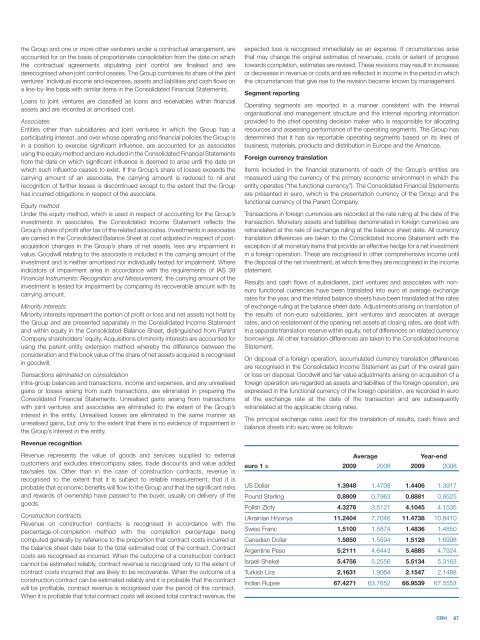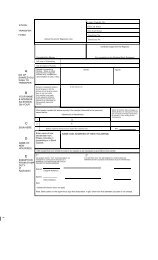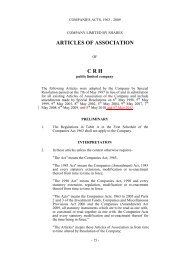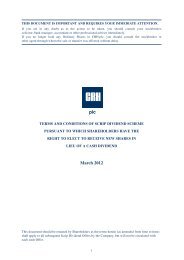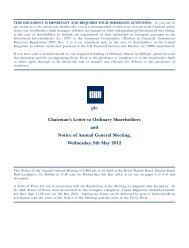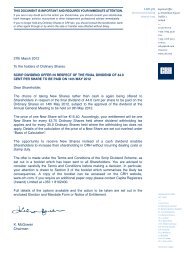2009 Annual Report - CRH
2009 Annual Report - CRH
2009 Annual Report - CRH
- TAGS
- annual
- www.crh.com
Create successful ePaper yourself
Turn your PDF publications into a flip-book with our unique Google optimized e-Paper software.
the Group and one or more other venturers under a contractual arrangement, are<br />
accounted for on the basis of proportionate consolidation from the date on which<br />
the contractual agreements stipulating joint control are finalised and are<br />
derecognised when joint control ceases. The Group combines its share of the joint<br />
ventures’ individual income and expenses, assets and liabilities and cash flows on<br />
a line-by-line basis with similar items in the Consolidated Financial Statements.<br />
Loans to joint ventures are classified as loans and receivables within financial<br />
assets and are recorded at amortised cost.<br />
Associates<br />
Entities other than subsidiaries and joint ventures in which the Group has a<br />
participating interest, and over whose operating and financial policies the Group is<br />
in a position to exercise significant influence, are accounted for as associates<br />
using the equity method and are included in the Consolidated Financial Statements<br />
from the date on which significant influence is deemed to arise until the date on<br />
which such influence ceases to exist. If the Group’s share of losses exceeds the<br />
carrying amount of an associate, the carrying amount is reduced to nil and<br />
recognition of further losses is discontinued except to the extent that the Group<br />
has incurred obligations in respect of the associate.<br />
Equity method<br />
Under the equity method, which is used in respect of accounting for the Group’s<br />
investments in associates, the Consolidated Income Statement reflects the<br />
Group’s share of profit after tax of the related associates. Investments in associates<br />
are carried in the Consolidated Balance Sheet at cost adjusted in respect of postacquisition<br />
changes in the Group’s share of net assets, less any impairment in<br />
value. Goodwill relating to the associate is included in the carrying amount of the<br />
investment and is neither amortised nor individually tested for impairment. Where<br />
indicators of impairment arise in accordance with the requirements of IAS 39<br />
Financial Instruments: Recognition and Measurement, the carrying amount of the<br />
investment is tested for impairment by comparing its recoverable amount with its<br />
carrying amount.<br />
Minority interests<br />
Minority interests represent the portion of profit or loss and net assets not held by<br />
the Group and are presented separately in the Consolidated Income Statement<br />
and within equity in the Consolidated Balance Sheet, distinguished from Parent<br />
Company shareholders’ equity. Acquisitions of minority interests are accounted for<br />
using the parent entity extension method whereby the difference between the<br />
consideration and the book value of the share of net assets acquired is recognised<br />
in goodwill.<br />
Transactions eliminated on consolidation<br />
Intra-group balances and transactions, income and expenses, and any unrealised<br />
gains or losses arising from such transactions, are eliminated in preparing the<br />
Consolidated Financial Statements. Unrealised gains arising from transactions<br />
with joint ventures and associates are eliminated to the extent of the Group’s<br />
interest in the entity. Unrealised losses are eliminated in the same manner as<br />
unrealised gains, but only to the extent that there is no evidence of impairment in<br />
the Group’s interest in the entity.<br />
Revenue recognition<br />
Revenue represents the value of goods and services supplied to external<br />
customers and excludes intercompany sales, trade discounts and value added<br />
tax/sales tax. Other than in the case of construction contracts, revenue is<br />
recognised to the extent that it is subject to reliable measurement, that it is<br />
probable that economic benefits will flow to the Group and that the significant risks<br />
and rewards of ownership have passed to the buyer, usually on delivery of the<br />
goods.<br />
Construction contracts<br />
Revenue on construction contracts is recognised in accordance with the<br />
percentage-of-completion method with the completion percentage being<br />
computed generally by reference to the proportion that contract costs incurred at<br />
the balance sheet date bear to the total estimated cost of the contract. Contract<br />
costs are recognised as incurred. When the outcome of a construction contract<br />
cannot be estimated reliably, contract revenue is recognised only to the extent of<br />
contract costs incurred that are likely to be recoverable. When the outcome of a<br />
construction contract can be estimated reliably and it is probable that the contract<br />
will be profitable, contract revenue is recognised over the period of the contract.<br />
When it is probable that total contract costs will exceed total contract revenue, the<br />
expected loss is recognised immediately as an expense. If circumstances arise<br />
that may change the original estimates of revenues, costs or extent of progress<br />
towards completion, estimates are revised. These revisions may result in increases<br />
or decreases in revenue or costs and are reflected in income in the period in which<br />
the circumstances that give rise to the revision became known by management.<br />
Segment reporting<br />
Operating segments are reported in a manner consistent with the internal<br />
organisational and management structure and the internal reporting information<br />
provided to the chief operating decision maker who is responsible for allocating<br />
resources and assessing performance of the operating segments. The Group has<br />
determined that it has six reportable operating segments based on its lines of<br />
business; materials, products and distribution in Europe and the Americas.<br />
Foreign currency translation<br />
Items included in the financial statements of each of the Group’s entities are<br />
measured using the currency of the primary economic environment in which the<br />
entity operates (“the functional currency”). The Consolidated Financial Statements<br />
are presented in euro, which is the presentation currency of the Group and the<br />
functional currency of the Parent Company.<br />
Transactions in foreign currencies are recorded at the rate ruling at the date of the<br />
transaction. Monetary assets and liabilities denominated in foreign currencies are<br />
retranslated at the rate of exchange ruling at the balance sheet date. All currency<br />
translation differences are taken to the Consolidated Income Statement with the<br />
exception of all monetary items that provide an effective hedge for a net investment<br />
in a foreign operation. These are recognised in other comprehensive income until<br />
the disposal of the net investment, at which time they are recognised in the income<br />
statement.<br />
Results and cash flows of subsidiaries, joint ventures and associates with noneuro<br />
functional currencies have been translated into euro at average exchange<br />
rates for the year, and the related balance sheets have been translated at the rates<br />
of exchange ruling at the balance sheet date. Adjustments arising on translation of<br />
the results of non-euro subsidiaries, joint ventures and associates at average<br />
rates, and on restatement of the opening net assets at closing rates, are dealt with<br />
in a separate translation reserve within equity, net of differences on related currency<br />
borrowings. All other translation differences are taken to the Consolidated Income<br />
Statement.<br />
On disposal of a foreign operation, accumulated currency translation differences<br />
are recognised in the Consolidated Income Statement as part of the overall gain<br />
or loss on disposal. Goodwill and fair value adjustments arising on acquisition of a<br />
foreign operation are regarded as assets and liabilities of the foreign operation, are<br />
expressed in the functional currency of the foreign operation, are recorded in euro<br />
at the exchange rate at the date of the transaction and are subsequently<br />
retranslated at the applicable closing rates.<br />
The principal exchange rates used for the translation of results, cash flows and<br />
balance sheets into euro were as follows:<br />
Average Year-end<br />
euro 1 = <strong>2009</strong> 2008 <strong>2009</strong> 2008<br />
US Dollar 1.3948 1.4708 1.4406 1.3917<br />
Pound Sterling 0.8909 0.7963 0.8881 0.9525<br />
Polish Zloty 4.3276 3.5121 4.1045 4.1535<br />
Ukrainian Hryvnya 11.2404 7.7046 11.4738 10.8410<br />
Swiss Franc 1.5100 1.5874 1.4836 1.4850<br />
Canadian Dollar 1.5850 1.5594 1.5128 1.6998<br />
Argentine Peso 5.2111 4.6443 5.4885 4.7924<br />
Israeli Shekel 5.4756 5.2556 5.5134 5.3163<br />
Turkish Lira 2.1631 1.9064 2.1547 2.1488<br />
Indian Rupee 67.4271 63.7652 66.9539 67.5553<br />
<strong>CRH</strong> 67


